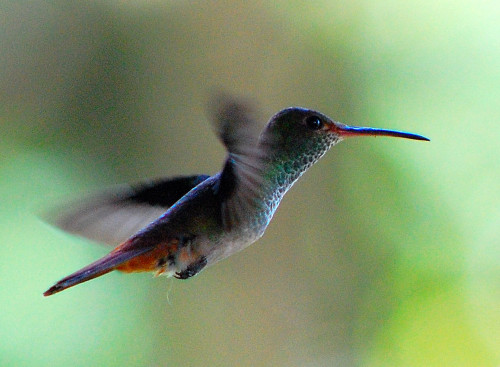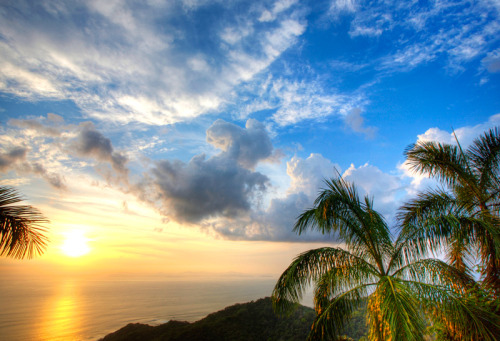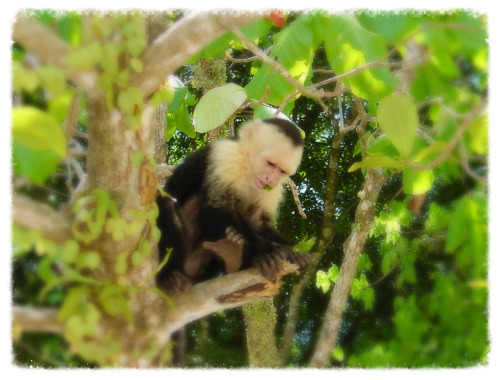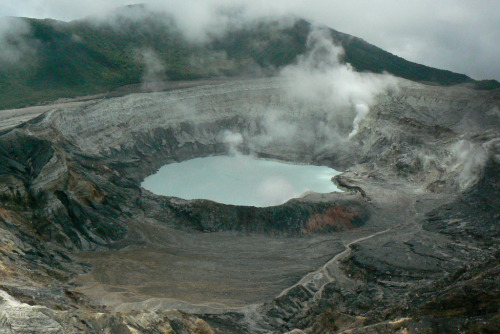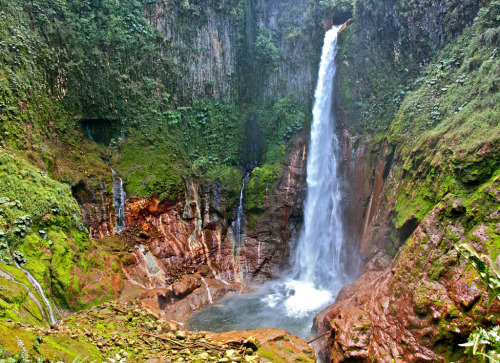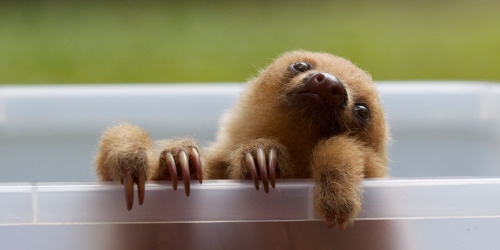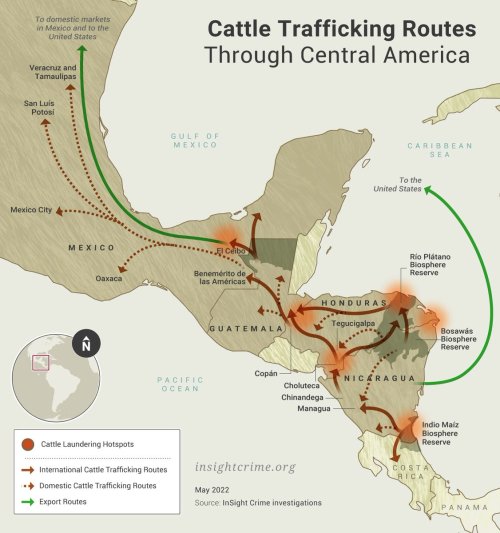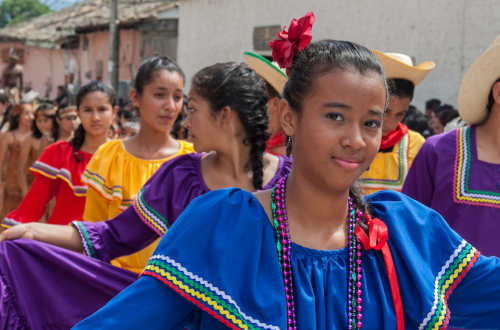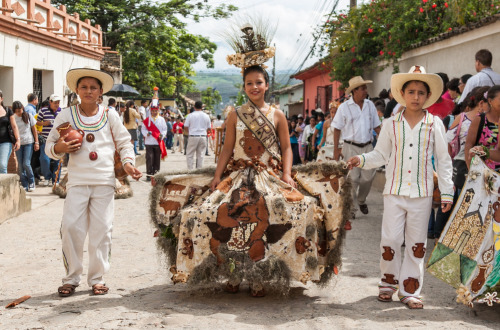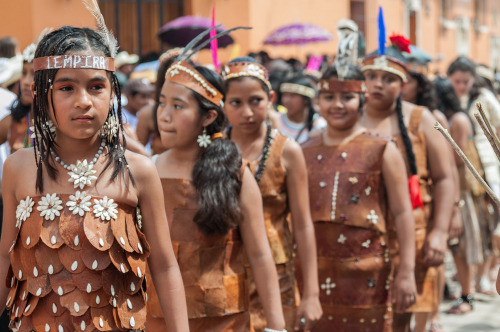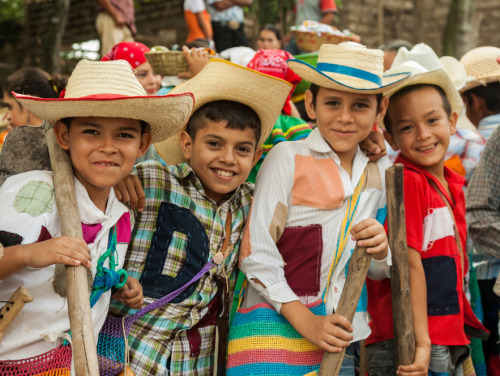#central america
Green Lagoon, Irazú Volcano
Within one of the multiple craters at the summit of the volcano Irazú is this green lake, so colored on account of its chemical content.
Photo: Cristina Valencia
Post link
Cocoa beans, raw ingredient of Costa Rican chocolate.
Many small-scale chocolate producers operate in Costa Rica, offering tours of their working facilities.
Photo: Everjean
Post link
Monkey silhouettes
A pair of monkeys, mother and child, spotted at the luxury resort Hacienda Pinilla, on the Nicoya Peninsula.
Photo: Paul Kehrer
Post link
Agujitas River at Drake Bay
The relatively short Agujitas River rises in the forested hills of the Osa Peninsula and empties into Drake Bay just north of Corcovado National Park.
Photo: Trish Hartmann
Post link
Hummingbird
Costa Rica is home to over 800 known species of birds. This hummingbird was photographed in Alajuela.
Photo: Jon Fife
Post link
Playa Herradura sunset
Another Pacific sunset, this one taken in Playa Herradura, one of the country’s most popular tourist draws, located an hour west of San Jose.
Photo: Andrew Morrell
Post link
Monteverde Cloud Forest Reserve
Near the town of the same name, in the Tilarán Mountains, this reserve protects a 26,000-acre tract of virgin rainforest consisting of six different eco zones and tremendous biodiversity.
Photo: Thomas Frost Jensen
Post link
White-headed capuchin
This is one of four species of monkey native to Costa Rica and probably the easiest to spot. It can make its home in pretty much any type of tropical forest.
Photo: Gloria Manna
Post link
Poas Volcano
A good 3,000 feet taller than Arenal is Volcán Poás, another active volcano in central Costa Rica. It has erupted 39 times since 1828 and has dual crater lakes near the summit.
Photo: Apetitu
Post link
Sunset over Manuel Antonio
On the central Pacific coast near Quepos, this is the sunset view from Buena Vista Villas & Casas, in Manuel Antonio National Park.
Photo: kansasphoto
Post link
Catarata del Toro
Just north of San Jose, this waterfall plunges from a hole in the cliff face 300 feet to the bottom of an extinct volcanic crater.
Photo: Steve Jurvetson
Post link
Vibrant butterfly
A large chunk of Costa Rica’s biodiversity is made up by its 300,000+ species of insects, which include 1,250 butterfly species—10% of the world’s total.
Post link
Pacific sunset.
A mellow sundowner on the Pacific coast near Nuevo Colon, Guanacaste.
Photo: Melissa Roy
Post link
Rolling hills
The mountains of Costa Rica run down the center of the country and are flanked by rolling green hills and farmland like this.
Photo: Ray Che
Post link
Baby two-toed sloth.
These arboreal mammals are native to Costa Rica. According to the photographer, this little guy is under the care of the Jaguar Rescue Center in Puerto Viejo de Talamanca.
Photo: Matt MacGillivray
Post link
Mango break.
One of the many tropical fruit options at markets in the capital San Jose and around the country.
Photo: Everjean
Post link
Laguna de Apoyo, Nicaragua. We drove down to the fresh water lake which sits in the crater of an extinct volcano. It was quiet, light rain, no one around except some locals fishing off floating logs.
The water was completely clear and we were so content we could have stayed there for hours.
Post link
Hundreds of thousands of cattle are trafficked each year through Central America and Mexico to meet the growing international demand for beef. Criminal networks have not missed this opportunity.
Post link
Hondurans in the town of Gracias partake in the annual Chief Lempira Day Festival
“The festival celebrates the Lencan leader Chief Lempira who managed to unite historically warring tribes as Spanish conquistadors descended in the 1500s. Chief Lempira ultimately cobbled together an anti-Spaniard force 30,000 strong which caused the Spaniards considerable trouble. The Lencan leader was eventually killed by the Spanish, however, and in his absence the popular uprising fizzled. But Chief Lempira’s legend lives on. The currency of Honduras is called the Lempira and he is still a hero to the Lencans. His annual festival day transforms Gracias, normally a sleepy town of 25,000, with a parade, fireworks, rock concerts, an air force fly over, even the President of Honduras helicopters in for the event.”
Source: http://trans-americas.com/blog/2012/05/gracias-honduras/
Post link
Hi guys! I was just thinking about how different Spanish vocabulary can be from region to region, and how so much of that comes from local languages. So, here are some regional words I’ve noticed in my travels that are pretty essential! (This is obviously not an exhaustive list of all words or regions, but I’ve chosen some of the most common words I’ve come across personally).
★From Nahuatl (Central Mexico)
aguacate| avocado [from ahuacatl]
atole | atole (traditional Mesoamerican drink) [from atolli]
cacahuate | peanut [from tlacucahuatl]
chamaco | young boy [from chamahuac]
chapulín | grasshopper [from chapol-in]
chayote | chayote (type of squash) [from chayotli]
chicle | gum [from chictli]
chipotle | chipotle (pepper) [from xipoctli]
comal | comal (type of flat pan used for making tortillas) [from comalli]
cuate | twin, buddy, friend [from cuatl*, which means serpent and twin]
elote | corn (on the cob) [from ēlō-tl]
esquite | corn (in a cup) [from izquitl]
escuincle | small child [from itzcuintli]
guacamole | guacamole [from ahuaca-molli]
guajalote | turkey [from wueh-xōlō-tl]
huarache | sandal; also a type of food, like an elongated taco. [from
kwarachi]
jícama | jicama (root) [from xicamatl]
jitomate | tomato [from xictomatl]
milpa | corn field [from milpa]
molcajete | kitchen mortar & pestle [from molcaxitl]
mitote | *it’s a dance, but can also mean ‘party’ or ‘disturbance’ or ‘racket’ [from mitotiqui]
nopal | cactus (edible variety) [from nopalli]
papalote | kite [from papalotl,originally ‘butterfly’]
petate | a woven matt [from petatl]
popote | drinking straw [from popotl]
pozole | a pre-Colombian stew [from potzolli]
pulque | pulque (alcohol) [from poliuhqui, originally ‘spoiled’]
tamal | tamale [from tamalli]
tecolote | owl [from tecolotl]
tianguis | market [from tianquiztli]
tlacuache| opossum [from tlacuatzin]
tocayo | namesake (person with the same name or named after) [from toca-yō-tl]
zacate | grass, weeds, lawn [from saka-tl]
★From Quechua (Inca Empire, primarily modern day Peru but also dialects in Ecuador, Bolivia, Argentina, Chile, and others in diaspora)
callampa | mushroom [from k’allampa]
cancha | soccer field [from kancha]
carpa | tent [from karpa]
chacra | small farm [from chakra]
charqui | jerky [from ch’arki]
Chile | Chile (country) [*one theory is that Chile was named for the Quechua word chiri meaning ‘cold,’ though this is unproven.]
choclo | corn [from choqllo]
chullo | hat with earflaps [from ch’ullu]
cochayuyo | an edible type of kelp/seaweed [from kochu=lake and yuyu=vegetable]
cura | priest [from kuraq]
guacho |cowboy [from wakcha(orphan) –> huacho (alone)]. *I think this is also likely related to waxo/wacho/wachito/guacho which in Chile I heard used to mean both ‘orphan’ or ‘young boy.’
guagua | baby, infant [from wawa]
guano | bird droppings, fertilizer [from wanu]
mate | a small gourd used to hold tea [from mati]
Pachamama | mother earth [from pacha= earth] *religious concept
poncho | poncho [*likely from punchu]
poroto | bean [from purutu]
quinua | quinoa [from kinwa]
tincar | to have a presentiment or feeling about something in the future [from tinku, which means ‘hit’ or ‘collision’]
yapa/llapa | a bonus, something free, a sale (in advertising) [from yapa=help, increase, something extra]
zapallo | a type of squash/pumpkin [from sapallu]
★ From Mapudungun (southern Chile & Argentina)
cahuin | mess, riot, disturbance [from cahuin(?)]
guata | belly [from huata]
huinca | foreigner; or, person who is not Mapuche [from wigka]
pichintún | a little bit [from pichintun(?)]
pilgua | a large bag [from pilguay]
pilucho | naked [from piluchi (?)]
pololo/a | boyfriend/girlfriend [from piulliu, which means ‘fly’ (insect) that circles someone]
ruca | a thatched hut [from ruka]
quiltro | street dog, mutt [from quiltro (?)]





